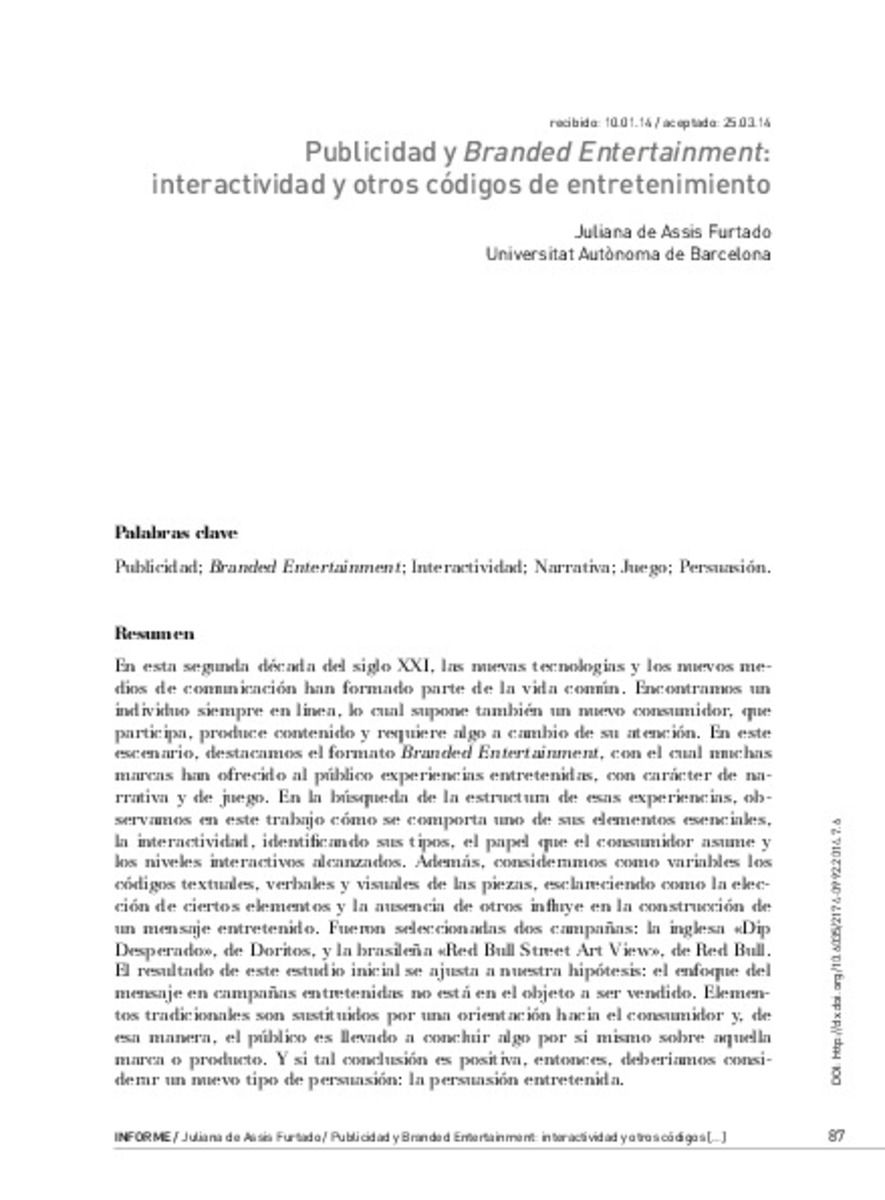Mostrar el registro sencillo del ítem
Publicidad y Branded Entertainment: interactividad y otros códigos de entretenimiento
| dc.contributor.author | De Assis Furtado, Juliana | |
| dc.date.accessioned | 2014-07-21T06:28:25Z | |
| dc.date.available | 2014-07-21T06:28:25Z | |
| dc.date.issued | 2014 | |
| dc.identifier.citation | De Assis, Juliana (2014). Publicidad y Branded Entertainment: interactividad y otros códigos de entretenimiento. En: adComunica. Revista Científica de Estrategias, Tendencias e Innovación en Comunicación, nº7. Castellón: Asociación para el Desarrollo de la Comunicación adComunica, Universidad Complutense de Madrid y Universitat Jaume I, 87-106. DOI: http://dx.doi.org/10.6035/2174- 0992.2014.7.6 | ca_CA |
| dc.identifier.issn | 2174-0992 | |
| dc.identifier.issn | 2254-2728 | |
| dc.identifier.uri | http://hdl.handle.net/10234/97462 | |
| dc.description.abstract | En esta segunda década del siglo XXI, las nuevas tecnologías y los nuevos medios de comunicación han formado parte de la vida común. Encontramos un individuo siempre en línea, lo cual supone también un nuevo consumidor, que participa, produce contenido y requiere algo a cambio de su atención. En este escenario, destacamos el formato Branded Entertainment, con el cual muchas marcas han ofrecido al público experiencias entretenidas, con carácter de narrativa y de juego. En la búsqueda de la estructura de esas experiencias, observamos en este trabajo cómo se comporta uno de sus elementos esenciales, la interactividad, identificando sus tipos, el papel que el consumidor asume y los niveles interactivos alcanzados. Además, consideramos como variables los códigos textuales, verbales y visuales de las piezas, esclareciendo como la elección de ciertos elementos y la ausencia de otros influye en la construcción de un mensaje entretenido. Fueron seleccionadas dos campañas: la inglesa «Dip Desperado», de Doritos, y la brasileña «Red Bull Street Art View», de Red Bull. El resultado de este estudio inicial se ajusta a nuestra hipótesis: el enfoque del mensaje en campañas entretenidas no está en el objeto a ser vendido. Elementos tradicionales son sustituidos por una orientación hacia el consumidor y, de esa manera, el público es llevado a concluir algo por sí mismo sobre aquella marca o producto. Y si tal conclusión es positiva, entonces, deberíamos considerar un nuevo tipo de persuasión: la persuasión entretenida. | ca_CA |
| dc.description.abstract | As we progress in the second decade of the 21st century, new technologies and new media have become a part of everyday life. This has created a new breed of consumer: an individual who is «always connected», participates, produces content and requires something in return for his attention. In this context, we highlight the Branded Entertainment format, through which so many brands have offered entertainment experiences, which feature a narrative and gameplay character to their targets. In this study, with the objective of identifying the composition of these experiences, we focused on the behavior of one of the key elements: the interactivity. We have identified various types of interactivity as well as the role assumed by the consumer and the interactive levels achieved. In addition, we consider the textual, verbal and visual elements of the pieces, clarifying how the election of certain elements and the absence of others influences the construction of an entertainment message. We selected to study two campaigns: the English «Dip Desperado», by Doritos, and the Brazilian «Red Bull Street Art View», by Red Bull. The results of our initial study confirm our hypothesis: that the focus of the message in entertainment campaigns is not on the object to be sold. Traditional elements are replaced by a consumer orientation and, thus, the target is led to an independent conclusion about the brand or product in question. If the outcome of this conclusion is positive, then we consider this a new type of persuasion: the entertainment persuasion. | ca_CA |
| dc.format.extent | 20 p. | ca_CA |
| dc.format.mimetype | application/pdf | ca_CA |
| dc.language.iso | spa | ca_CA |
| dc.publisher | AdComunica, Asociación para el desarrollo de la comunicación | ca_CA |
| dc.publisher | Departamento de Ciencias de la Comunicación, Universitat Jaume I | ca_CA |
| dc.publisher | Departamento de Comunicación Audiovisual y Publicidad II, Universidad Complutense de Madrid | ca_CA |
| dc.relation.isPartOf | adComunica, 2014, nº 7 | ca_CA |
| dc.rights.uri | http://creativecommons.org/licenses/by-sa/4.0/ | * |
| dc.subject | Branded Entertainment | ca_CA |
| dc.subject | Interactividad | ca_CA |
| dc.subject | Narrativa | ca_CA |
| dc.subject | Juego | ca_CA |
| dc.subject | Persuasión | ca_CA |
| dc.subject | Interactivity | ca_CA |
| dc.subject | Narrative | ca_CA |
| dc.subject | Game | ca_CA |
| dc.subject | Persuasion | ca_CA |
| dc.subject.other | Comunicació Social -- Revistes | ca_CA |
| dc.subject.other | Fons local -- Revistes | ca_CA |
| dc.title | Publicidad y Branded Entertainment: interactividad y otros códigos de entretenimiento | ca_CA |
| dc.type | info:eu-repo/semantics/article | ca_CA |
| dc.identifier.doi | http://dx.doi.org/10.6035/2174-0992.2014.7.6 | |
| dc.rights.accessRights | info:eu-repo/semantics/openAccess | ca_CA |
| dc.relation.publisherVersion | http://www.adcomunicarevista.com/ojs/index.php/adcomunica/article/view/148/170 | ca_CA |
Ficheros en el ítem
Este ítem aparece en la(s) siguiente(s) colección(ones)
-
adComunica_2014_no .7 [19]
AdComunica nº 7 ( 2014)








